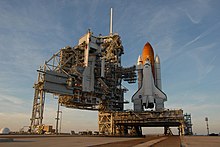Kennedy Space Center Launch Complex 39
Northern Merritt Island was first developed around 1890 when a few wealthy Harvard University graduates purchased 18,000 acres (73 km2) and constructed a three-story mahogany clubhouse, very nearly on the site of Pad 39A.[10] During the 1920s, Peter E. Studebaker Jr., son of the automobile magnate, built a small casino at De Soto Beach eight miles (13 km) north of the Canaveral lighthouse.In March 1963, plans were formalized to build only two of the three pads; the northernmost, furthest from the VAB, would not be built but reserved for future expansion.At the end of the arm, the white room provided an environmentally controlled and protected area for astronauts and their equipment before entering the spacecraft.Each crawler weighed 6,000,000 pounds (2,720 t) and was capable of keeping the space vehicle and its launcher platform level while negotiating the 5 percent grade to the pad.[21] The four-story Launch Control Center (LCC) was located 3.5 miles (5.6 km) away from Pad A, adjacent to the Vehicle Assembly Building, for safety.Each pad had a 200-foot (61 m) evacuation tube running from the Mobile Launcher platform to a blast-resistant bunker 39 feet (12 m) underground, nicknamed Rubber room, equipped with survival supplies for 20 persons for 24 hours and reachable through a high-speed elevator.[25] A further Emergency Egress System was installed to allow fast escape of crew or technicians from pad in case of imminent catastrophic failure of the rocket.[26] The system included seven baskets suspended from seven slidewires that extended from the fixed service structure to a landing zone 370 meters (1,200 ft) to the west.The mobile launchers were then modified for the shorter Saturn IB rockets, by adding a "milk-stool" extension platform to the launch pedestal, so that the S-IVB upper stage and Apollo spacecraft swing arms would reach their targets.These were used for three crewed Skylab flights and the Apollo–Soyuz Test Project, since the Saturn IB pads 34 and 37 at Cape Canaveral SFS had been decommissioned.[29][30] The thrust to allow the Space Shuttle to achieve orbit was provided by a combination of the Solid Rocket Boosters (SRBs) and the RS-25 engines.The FSS permitted access to the Shuttle via a retractable arm and a "beanie cap" to capture vented LOX from the external tank.The Gaseous Oxygen Vent Arm positioned a hood, often called the "Beanie Cap", over the top of the external tank (ET) nose cone during fueling.[when?]The GUCP provided support for plumbing and cables, called umbilicals, that transferred fluids, gases, and electrical signals between two pieces of equipment.Assisted by members of the closeout team, the crew would leave the orbiter and ride an emergency basket to the ground at speeds reaching up to 55 miles per hour (89 km/h).[37] The subsequent investigation found that the damage was the result of carbonation of epoxy and corrosion of steel anchors that held the refractory bricks in the trench in place.After the Apollo–Soyuz Test Project, 39B was reconfigured similarly to 39A; but due to additional modifications (mainly to allow the facility to service a modified Centaur-G upper stage), along with budgetary restraints, it was not ready until 1986.Prior to the SpaceX lease agreement, the pad remained as it was when Atlantis launched on the final shuttle mission on July 8, 2011, complete with a mobile launcher platform.[48] Prior to the end of the bid period, and prior to any public announcement by NASA of the results of the process, Blue Origin filed a protest with the U.S. General Accounting Office (GAO) "over what it says is a plan by NASA to award an exclusive commercial lease to SpaceX for use of mothballed space shuttle launch pad 39A."[49] On December 12, 2013, the GAO denied the protest and sided with NASA, which argued that the solicitation contained no preference on the use of the facility as multi-use or single-use.[51] The pad was modified to support launches of both Falcon 9 and Falcon Heavy launch vehicles, modifications that included the construction of a large Horizontal Integration Facility (HIF) similar to that used at existing SpaceX-leased facilities at Cape Canaveral Space Force Station and Vandenberg Air Force Base, horizontal integration being markedly difference from the vertical integration process used to assemble NASA's Apollo and Space Shuttle vehicles at the launch complex.Additionally, new instrumentation and control systems were installed, and substantial new plumbing was added for a variety of rocket liquids and gases.SpaceX originally planned to be ready to accomplish the first launch at pad 39A—of a Falcon Heavy—as early as 2015,[52] as they had had architects and engineers working on the new design and modifications since 2013.In 2019, SpaceX began substantial modification to LC 39A in order to begin work on phase 1 of the construction to prepare the facility to launch prototypes of the large 9 m (30 ft)-diameter methalox reusable rocket—Starship—from a launch stand, which would fly from 39A on suborbital test flight trajectories with six or fewer Raptor engines.The second Falcon Heavy flight, carrying the Arabsat-6A communications satellite for Arabsat of Saudi Arabia, successfully launched on April 11, 2019.[9] The concrete pad measures about 50 feet (15 m) wide by about 100 feet (30 m) long and could support the combined weight of a fueled launch vehicle, payload, and customer-provided launch mount up to about 132,000 pounds (60,000 kg), and an umbilical tower structure, fluid lines, cables, and umbilical arms weighing up to about 47,000 pounds (21,000 kg).As part of the Environmental Impact Study (EIS) process, this proposed launch complex was consolidated from two pads (designated in the 1963 plans as 39C and 39D) to one that would provide greater separation from LC-39B.The area was expanded to accommodate a wider variety of launch azimuths, helping to protect against potential overflight concerns of LC-39B.[81][80] Space Florida has proposed that Launch Complex 48 be developed for use by Boeing's Phantom Express and that three landing pads be built for reusable booster systems, to provide more landing options for SpaceX's Falcon 9 and Falcon Heavy, Blue Origin's New Glenn, and other potential reusable vehicles.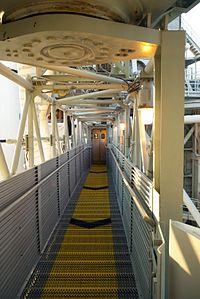
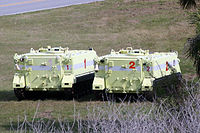

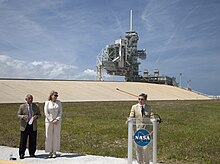
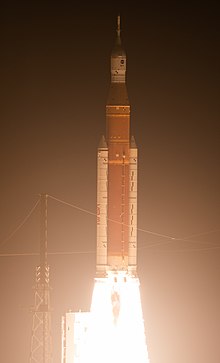

Baikonur Cosmodrome Site 200Kennedy Space CenterSpaceXOrbital inclinationPad 39ASaturn VSA-501Falcon 9 Block 5Spainsat NGSpace ShuttleFalcon 9Falcon HeavyStarshipPad 39BSA-505Space Launch SystemArtemis ISaturn IBAres I-XU.S. National Register of Historic PlacesTitusville, Floridarocket launch siteJohn F. Kennedy Space CenterMerritt IslandFloridaApollo programSpace Shuttle programVehicle Assembly BuildingCrawlerwaycrawler-transportersmobile launcher platformsOrbiter Processing FacilityLaunch Control Centernews facilityConstellation programArtemis programsmall-lift launch vehiclesEastern Test Rangethe automobile magnateCape CanaveralCape Canaveral Space Force Stationcreation of NASAProject MercuryProject GeminiApollo 11Atlas-Centaurdirect ascentEarth orbit rendezvousNova-classPlayalinda BeachAstronaut Beach Houselunar orbit rendezvousApollo spacecraftMobile LaunchersLaunch Umbilical Towerwhite roomnuclear rocket enginesKennedy Space Center Visitor Complexflame deflectorsRubber roomMobile Launcher PlatformApollo–Soyuz Test ProjectApollo 4Apollo 6Apollo 10Apollo 8SkylabAtlantisLaunch Complex 39ASolid Rocket Boostersliquid hydrogenliquid oxygenexternal tankLouisianaApollo–SoyuzGround Umbilical Carrier PlateSTS-127STS-119STS-133M113A2 Firefighting VehiclesM113 APC.STS-124refractory brickshydrochloric acidColumbiaCentaur-GSTS-51-LChallenger disasterSTS-26STS-117retirement of the Shuttle fleetretirement of the Space Shuttleprivate companiesSpace FloridaState of Floridaeconomic development agencySTS-116STS-125EndeavourSTS-400Ares I-XKennedy Space Center Launch Complex 39A#SpaceXBob CabanaGwynne Shotwellcommercial useJeff BezosBlue OriginUnited Launch AllianceGeneral Accounting OfficeHorizontal Integration FacilityVandenberg Air Force Basevertical integrationTransporter Erectorwet dress rehearsalprototypesmethaloxRaptorSpaceX CRS-10Cape Canaveral's Space Launch Complex 40AMOS-6National Reconnaissance Officemaiden launchElon MuskTesla RoadsterCrew DragonArabsat-6A
